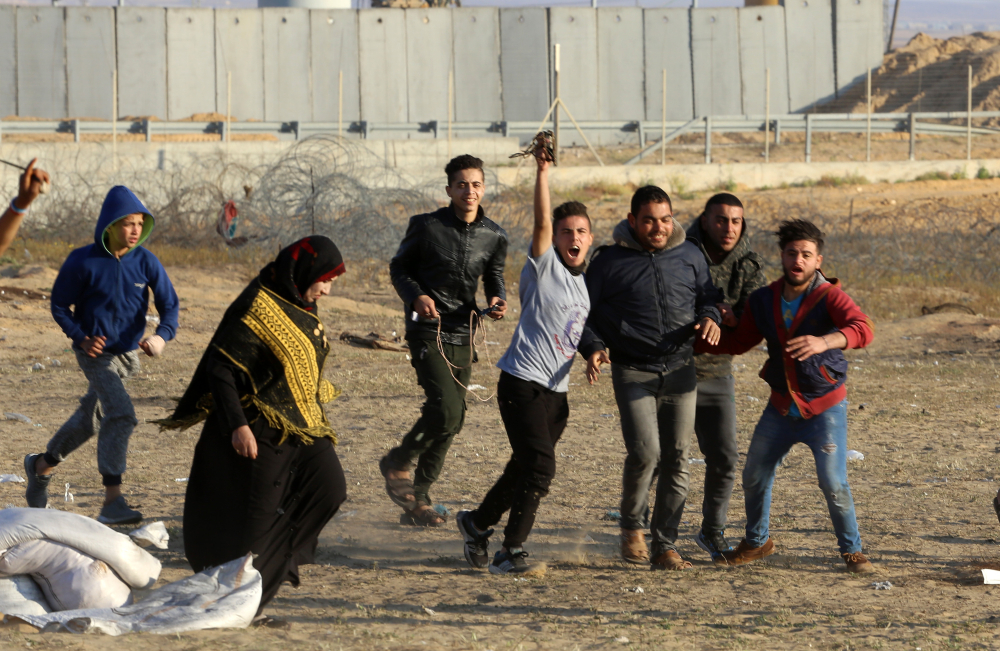by Mitchell Plitnick
Palestinian officials say at least 58 people have been killed in the latest round of protests. More than 2,700 Palestinian demonstrators were injured on Monday—at least 1,350 by gunfire—along the border fence with Gaza, the Health Ministry reported. The mass protests began on March 30 and had already left dozens dead.
Those words appeared in The New York Times on May 14, 2018. On that day, the protests in Gaza had the added inspiration not only of the anniversary of the naqba the following day—which Israel celebrates as its independence day—but also the infuriating sight of Jared Kushner and Ivanka Trump, joined by a bevy of Republicans, anti-Semitic preachers, and Israeli settlers with their American supporters celebrating the move of the U.S. embassy in Israel from Tel Aviv to Jerusalem.
Two days ago, as the latest spike in violence in Gaza wound down, the Times stated, “It was the worst violence between the two sides since a 50-day war in 2014.” The Jerusalem Post had reported the day before that “Four Israelis died during the continued rocket attacks.” The Post also stated that, “234 patients have been treated” at local hospitals in Israel, and that “25 Palestinians were killed…and 154 others were injured” in the fighting.
The comparison of these tragic tallies led Yousef Munayyer of the US Campaign for Palestinian Rights to ponder, “Worst violence since 2014? Israel shot 1,100 Palestinians and killed 60 in Gaza, including 7 children on May 14th, 2018. That was just last year. What makes this worse? Go ahead, I’ll wait.”
Of course, what makes it worse is that in May of 2018, no Israelis were hurt. The Times might just as well have said outright that Palestinian lives are worthless. But it was far from alone. Many other outlets echoed the same callous point.
As usual, there was a long and steady stream of bipartisan statements supporting Israel’s right to defend itself, but nary a peep about the same right for Palestinians. And these statements of concern for Israeli lives only—many of them dutifully retweeted by AIPAC—imply that, by their very nature, Israel can only be defending itself while the Palestinians must be the vicious aggressors.
This time there have been some eloquent pleas for justice, but they stood like isolated sweet notes in a raucous cacophony. For example, in response to a Times headline that framed the events as Israel responding to Hamas launching hundreds of missiles, Rep. Rashida Tlaib (D-MI) tweeted, “When will the world stop dehumanizing our Palestinian people who just want to be free? Headlines like this and framing it in this way just feeds into the continued lack of responsibility on Israel who unjustly oppress and target Palestinian children and families.”
Naturally, she was attacked from conservative corners, complete with accusations of anti-Semitism and, ironically, of dual loyalty.
Rep. Ilhan Omar (D-MN) also put out a statement. She tweeted,
How many more protesters must be shot, rockets must be fired, and little kids must be killed until the endless cycle of violence ends? The status quo of occupation and humanitarian crisis in Gaza is unsustainable. Only real justice can bring about security and lasting peace.
Omar’s explicit expression of concern for Israelis—embodied in the reference to the rockets as well as the universal concern for children—meant nothing to critics who simply will not allow a progressive, Muslim woman of color to be heard, drowning out her words in accusations of “support for terrorism.”
Changing the Chronology
The framing to which Tlaib objected follows a familiar pattern. For the Times’ headline writer, Israel’s onslaught was a response to Hamas’ rockets. In another Times article, the ostensible “newspaper of record” reported that “This latest round of fighting appeared to have been set off by events on Friday, when two Israeli soldiers were wounded by a Gaza sniper and four Palestinians were killed.”
In just about all of the media in the United States and much of the world, that became the story. More precisely, that became the story for better-informed readers in much of the world. The less informed simply understood that Israel was responding to rocket fire from Hamas.
In fact, this was not the proximate cause of the latest exchange of Gaza rockets and Israeli missiles and bombs.
On Friday, Palestinians in Gaza gathered, as they have every Friday for well over a year, for the weekly “Great March of Return” protest. As is all too often the case, Israeli soldiers fired at the protesters in several locations along the barrier cordoning off Gaza, killing two Palestinian protesters. Shortly after, gunfire near the barrier lightly wounded two Israeli soldiers, after which Israel launched an airstrike that killed two more Palestinians. And the escalation began.
Absence of Context
The reporting also stripped away the larger context of the weekend’s violence. Gaza remains under siege, and the situation there continues to deteriorate. The United Nations predicted back in 2012 that Gaza would be unlivable by 2020, and it has not changed that assessment.
Despair is not static. It grows with every day of hopelessness. Making matters worse, Israel was not holding up its side of the previous cease-fire agreement between Hamas and Israel—an agreement essentially identical to the one that ended this last escalation and returned Gaza to the daily violence of the siege it lives under.
Under the agreement, Hamas would prevent attacks on Israel. In exchange, Israel would permit $15 million per month in cash from Qatar to enter the Strip. It would also relax border and coastline restrictions, allowing a bit more movement in and out of Gaza and fishing farther off the coastline. But the Qatari cash was delayed, and the ease in restrictions did not materialize.
The Israeli military leadership appealed to the right-wing government of Benjamin Netanyahu to fully implement the agreement, believing that “the understandings reached between Egypt, Hamas and the Islamic Jihad created an opportunity that Israel ought to seize.” Apparently, Netanyahu disagreed.
Warping the Narrative
The indiscriminate firing of rockets toward civilian areas by Palestinian groups is contrary to international humanitarian law (IHL). But the outrage expressed by leaders in Washington from both parties and the way the American media portrays the entire episode means that the situation in Gaza—and, yes, in southern and central Israel as well—is only going to get worse.
Outrage, or the application of IHL, should not be reserved for only one side, especially when it’s the side with far less ability to do damage. So, too, the rockets from Gaza, or the deaths, injuries and destruction they caused in Israel should not be ignored. But there is no danger of that. It’s quite clear that Israelis have lots of support in this regard, as well as a military that can protect them.
But a false narrative that portrays Palestinians as less than human, violent, and unworthy of sympathy not only reinforces the very impunity that leads Israel to continue its siege, occupation, and growing apartheid, but feeds Palestinian despair, hopelessness, and, perhaps most importantly, degradation. How must it feel to repeatedly see such indifference to the kind of suffering that is daily life in Gaza, punctuated by “flareups” that destroy more infrastructure, level more buildings, and take more lives?
It must stop. A good first step would be for everyone who holds a vision of universal human values to support Rashida Tlaib and Ilhan Omar against the vicious attacks they are enduring every day. A good next step is for liberal voters within the Democratic party—and in similar political parties around the world—to make it clear that Palestinian and Israeli lives are of equal importance.






Tiny Gaza Strip has one of the highest population densities in the world, despite having no economy, and out of the 1.8 million people living there, 1.3 million are actually refugees, forced to live there after expulsion from their own homes and lands by Israel. Remember that next time they say that Israel was “attacked” from Gaza. Who has been attacking whom?
The population of tiny Gaza Strip is 1.8 million, of which 1.2 million are refugees forced to live there by Israel after expulsion from their own lands and homes.